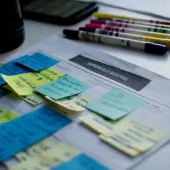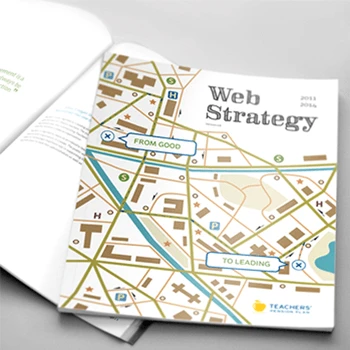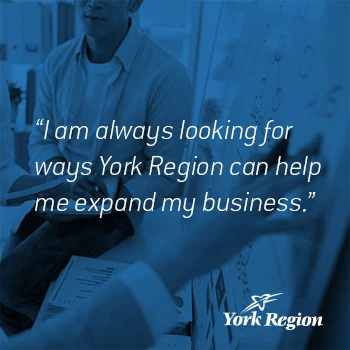What exactly is UX design ops consulting and why do organizations need it?
UX design ops consulting helps organizations build mature, scalable design operations that deliver exceptional experiences consistently. It addresses the gap between having design talent and having systematic processes that enable that talent to work effectively at scale. Design ops consulting focuses on optimizing research and UX design operations, processes, and culture to enable experience delivery again and again rather than one-off successes.
Tip: Assess whether your organization struggles with inconsistent design quality, slow delivery, or difficulty scaling UX work before engaging design ops consulting to ensure you're addressing operational rather than just capability challenges.
How does design ops consulting differ from traditional UX consulting services?
Traditional UX consulting focuses on specific projects or deliverables like research studies or design artifacts. Design ops consulting addresses the systems, processes, and organizational structures that enable sustainable UX excellence. It emphasizes building internal capabilities, establishing governance frameworks, and creating repeatable processes that deliver consistent results across multiple projects and teams.
Tip: Choose design ops consulting when you need systematic improvements rather than project-specific solutions, especially if you have recurring operational challenges across multiple UX initiatives.
What operational challenges does design ops consulting typically address?
Common challenges include inconsistent design quality across projects, lack of systematic design processes, poor collaboration between design and development, absence of design system governance, difficulty scaling UX work, and unclear roles and responsibilities. Design ops consulting also addresses culture issues like low UX maturity and insufficient organizational support for experience-centered decision-making.
Tip: Document specific operational pain points your organization experiences before engaging consultants to ensure the engagement addresses your most critical systematic challenges rather than symptom-level issues.
How do we determine if our organization needs design ops consulting?
Organizations typically need design ops consulting when they have design talent but struggle with systematic delivery, face recurring quality issues, experience bottlenecks in design workflow, or cannot scale UX work effectively. Other indicators include frequent design drift during development, lack of design system adoption, poor cross-functional collaboration, or executive frustration with UX team output and impact.
Tip: Conduct an honest assessment of your design operations maturity across strategy, research, design, testing, and build phases using established frameworks to identify specific areas where consulting support would provide the greatest impact.
What experience thinking principles guide design ops consulting approaches?
Experience Thinking principles emphasize connecting brand, content, product, and service experiences through systematic operational excellence. Design ops consulting applies these principles by building processes that ensure consistency across all experience touchpoints, establishing governance that maintains experience quality, and creating organizational capabilities that support holistic experience creation rather than isolated design activities.
Tip: Evaluate potential consultants based on their understanding of how operational improvements connect to overall experience strategy rather than just their knowledge of design tools and processes.
What organizational maturity levels benefit most from design ops consulting?
Organizations at ramping up and approaching maturity stages typically benefit most from design ops consulting. Early stage organizations may need foundational UX capabilities first, while mature organizations often have established operations. Mid-maturity organizations have design talent but lack systematic processes, governance frameworks, and scalable operations that design ops consulting addresses effectively.
Tip: Honestly assess your organization's current UX maturity level before engaging design ops consulting to ensure the engagement matches your readiness for operational improvements rather than basic capability building.
How does design ops consulting address different organizational contexts?
Design ops approaches vary based on organizational size, industry, culture, and existing capabilities. Large organizations may need complex governance frameworks and matrix team structures, while smaller organizations might benefit from simplified processes and centralized approaches. Industry context affects compliance requirements, process complexity, and stakeholder management approaches that design ops consulting must address.
Tip: Share detailed information about your organizational context, constraints, and culture with potential consultants to ensure their approach aligns with your specific operational realities rather than generic best practices.
What design processes does design ops consulting typically optimize?
Process optimization covers the complete Experience Thinking lifecycle including strategy development, user research planning and execution, design creation and iteration, usability testing coordination, and development handoff management. It also addresses cross-functional collaboration workflows, design review processes, quality assurance procedures, and feedback integration mechanisms that ensure consistent experience delivery.
Tip: Map your current design processes before consulting begins to identify specific bottlenecks, handoff issues, and quality control gaps that process optimization should prioritize rather than assuming generic process improvements will address your specific challenges.
How does design ops consulting improve collaboration between design and development?
Collaboration improvements include establishing clear handoff procedures, creating design specifications that prevent design drift, implementing regular design-development check-ins, and building shared understanding of design requirements. Design ops consulting addresses communication gaps, establishes accountability frameworks, and creates processes that maintain design quality throughout development cycles.
Tip: Include both design and development representatives in design ops consulting discussions to ensure process improvements address real collaboration challenges rather than just design team preferences and assumptions.
What role does design system governance play in design ops consulting?
Design system governance establishes frameworks for maintaining consistency, managing system evolution, and ensuring adoption across projects and teams. Design ops consulting creates governance structures that balance design system consistency with innovation flexibility, establishes decision-making authorities, and builds processes for system maintenance and expansion that scale with organizational growth.
Tip: Focus governance frameworks on principles and outcomes rather than rigid rules to enable appropriate adaptation while maintaining consistency, especially in organizations with diverse product lines or market requirements.
How does design ops consulting address quality assurance and design drift prevention?
Quality assurance includes establishing design review checkpoints, creating quality criteria and measurement frameworks, implementing design drift monitoring processes, and building feedback loops that catch quality issues before they impact user experience. Design ops consulting creates systematic approaches to maintaining design integrity throughout development and deployment cycles.
Tip: Build quality assurance processes that integrate with existing development workflows rather than creating separate design quality systems that may be ignored or circumvented under time pressure.
What measurement and analytics frameworks does design ops consulting establish?
Measurement frameworks include design process efficiency metrics, quality indicators, collaboration effectiveness measures, and experience impact tracking. Design ops consulting establishes both operational metrics that track process performance and outcome metrics that demonstrate business value, creating dashboard and reporting systems that support continuous improvement.
Tip: Balance process metrics with outcome metrics to avoid optimizing for efficiency at the expense of experience quality, and ensure measurement frameworks connect design operations performance to business results.
How does design ops consulting optimize research operations and integration?
Research operations optimization includes participant recruitment systems, research repository management, insight synthesis processes, and research-to-design handoff procedures. Design ops consulting establishes research planning frameworks, creates standardized methodologies, and builds systems that ensure research insights effectively inform design decisions across projects and teams.
Tip: Create research operations that can support both strategic research initiatives and rapid tactical research needs rather than optimizing only for one type of research to maintain operational flexibility.
What content governance and management processes does design ops consulting address?
Content governance includes content strategy frameworks, creation and review processes, archiving and retention policies, and content quality management systems. Design ops consulting establishes workflows that ensure content consistency across touchpoints, creates approval processes that maintain quality standards, and builds systems for content lifecycle management that scale with organizational needs.
Tip: Integrate content governance with design system governance to ensure content and visual design consistency work together rather than creating separate systems that may conflict or create operational inefficiencies.
What team structure options does design ops consulting recommend?
Design ops consulting evaluates centralized, decentralized, and matrix team structures based on organizational context, project complexity, and collaboration requirements. Centralized structures offer consistency and professional development but may create resource bottlenecks. Decentralized structures provide nimbleness but risk inconsistency. Matrix structures balance both approaches but require sophisticated coordination mechanisms.
Tip: Choose team structures based on your organization's actual collaboration patterns and resource allocation realities rather than theoretical organizational preferences or industry trends.
How does design ops consulting optimize centralized design team operations?
Centralized team optimization includes resource allocation frameworks, project prioritization systems, capacity planning processes, and stakeholder management structures. Design ops consulting addresses the common problem of centralized teams becoming overwhelmed with demand by creating systematic approaches to managing requests, setting expectations, and maintaining quality standards while serving multiple business areas.
Tip: Establish clear criteria for prioritizing design work and transparent communication about capacity constraints to prevent centralized teams from becoming order-taking services that compromise strategic impact for tactical responsiveness.
What are the operational considerations for decentralized design teams?
Decentralized operations require communication frameworks that enable knowledge sharing, governance systems that maintain consistency across teams, and professional development programs that prevent skill stagnation. Design ops consulting addresses the challenge of maintaining design standards and enabling collaboration when designers are embedded in different business units or product areas.
Tip: Create regular cross-team collaboration opportunities and shared learning initiatives to prevent decentralized teams from developing inconsistent approaches or missing opportunities for knowledge sharing and professional growth.
How does matrix team structure work in design operations?
Matrix structures combine centralized expertise with embedded collaboration by having designers report to a central design organization while working temporarily in specific business areas. Design ops consulting establishes rotation systems, project assignment processes, and dual accountability frameworks that leverage both design expertise and domain knowledge while maintaining team cohesion and professional development.
Tip: Plan matrix rotations based on learning objectives and business needs rather than just resource availability to maximize both professional development and project impact while maintaining operational stability.
What role definition and career development frameworks does design ops consulting create?
Role frameworks include clear responsibility definitions for visual designers, interaction designers, UX researchers, content strategists, and design operations specialists. Design ops consulting creates career advancement pathways, skill development programs, and performance evaluation systems that support professional growth while meeting organizational needs for design expertise and leadership.
Tip: Create role definitions that balance specialization with collaboration flexibility to enable both deep expertise development and cross-functional teamwork as organizational needs and individual careers evolve.
How does design ops consulting address cross-functional collaboration challenges?
Cross-functional collaboration includes establishing shared language and processes with product management, engineering, marketing, and business stakeholders. Design ops consulting creates collaboration frameworks, communication protocols, and decision-making structures that enable effective partnership while maintaining design quality and user-centered decision-making throughout development processes.
Tip: Focus collaboration improvements on outcome alignment and shared success metrics rather than just process changes to ensure cross-functional partnerships create genuine value rather than just improved communication frequency.
What scaling strategies does design ops consulting recommend for growing organizations?
Scaling strategies include hiring frameworks that maintain quality while expanding capacity, onboarding processes that accelerate new team member productivity, and organizational structures that can adapt to growth without losing effectiveness. Design ops consulting creates scalable systems and processes that can accommodate team growth while maintaining design quality and operational efficiency.
Tip: Plan scaling strategies that prioritize capability development alongside capacity expansion to ensure organizational growth enhances rather than dilutes design impact and strategic influence.
How does design ops consulting drive experience-oriented culture transformation?
Culture transformation involves embedding Experience Thinking principles into organizational decision-making, establishing user-centered success metrics, and creating rituals that reinforce experience-focused values. Design ops consulting addresses cultural barriers to UX adoption, builds organizational understanding of experience value, and creates systematic approaches to culture change that sustain beyond consulting engagement.
Tip: Focus culture transformation on behavior changes and decision-making processes rather than just awareness and education activities to create lasting organizational changes that influence how work gets done.
What change management approaches does design ops consulting use?
Change management includes stakeholder engagement strategies, pilot program implementation, success demonstration approaches, and resistance management techniques. Design ops consulting creates change roadmaps that build organizational confidence through incremental wins while working toward systematic transformation of how the organization approaches experience creation and delivery.
Tip: Plan change management with both quick wins and long-term transformation goals to maintain momentum while building sustainable organizational capabilities that continue after consulting support ends.
How does design ops consulting build organizational UX maturity?
UX maturity development includes capability assessment, skill development planning, process sophistication advancement, and strategic integration enhancement. Design ops consulting creates systematic approaches to advancing organizational maturity across strategy, research, design, testing, and implementation phases while building leadership understanding and support for continued investment.
Tip: Assess UX maturity across all organizational functions rather than just design teams to identify systematic barriers to advancement and ensure maturity development addresses organizational ecosystem rather than just UX capabilities.
What stakeholder engagement strategies does design ops consulting employ?
Stakeholder engagement includes executive education about experience value, middle management involvement in process development, and frontline staff training in experience delivery. Design ops consulting creates engagement approaches that address different stakeholder concerns and motivations while building coalition support for experience-centered organizational transformation.
Tip: Tailor stakeholder engagement approaches to individual motivations and concerns rather than using generic change communication to build genuine support for operational improvements across different organizational levels and functions.
How does design ops consulting address resistance to UX process improvements?
Resistance management includes understanding root causes of opposition, addressing specific concerns through demonstration and education, and creating safe spaces for experimentation with new approaches. Design ops consulting recognizes that resistance often stems from resource concerns, unclear value propositions, or process complexity rather than opposition to better experiences.
Tip: Address resistance through demonstration projects and incremental improvements rather than comprehensive process overhauls to build confidence and organizational support while reducing change-related anxiety and disruption.
What training and capability development does design ops consulting include?
Training includes process education, tool proficiency development, collaboration skill building, and strategic thinking advancement. Design ops consulting creates learning programs that build both individual capabilities and organizational knowledge while establishing internal coaching and mentoring systems that sustain capability development after formal training completion.
Tip: Combine formal training with practical application opportunities and peer learning initiatives to accelerate capability development and ensure new skills integrate effectively into daily work practices.
How does design ops consulting establish sustainable organizational learning systems?
Learning systems include knowledge management frameworks, best practice documentation, retrospective processes, and continuous improvement mechanisms. Design ops consulting creates organizational capabilities for capturing, sharing, and applying learnings that enable continued operational advancement and adaptation to changing business needs without ongoing external support.
Tip: Build learning systems that integrate with existing organizational knowledge management rather than creating separate design-specific systems that may not be maintained or accessed by broader organizational stakeholders.
What design governance frameworks does design ops consulting establish?
Design governance includes decision-making authorities, quality standards, approval processes, and accountability structures that ensure consistent experience delivery while enabling innovation and efficiency. Design ops consulting creates governance frameworks that balance control with creativity, establishing clear guidelines while maintaining flexibility for different project types and organizational contexts.
Tip: Design governance frameworks based on outcome accountability rather than process compliance to enable appropriate adaptation while maintaining quality standards and strategic alignment.
How does design ops consulting create design system governance structures?
Design system governance includes contribution processes, evolution management, adoption tracking, and maintenance responsibilities. Design ops consulting establishes governance structures that enable distributed contribution while maintaining system integrity, creates decision-making frameworks for system changes, and builds adoption support that scales with organizational growth and complexity.
Tip: Balance design system governance between consistency enforcement and innovation enablement to ensure systems support rather than constrain creative problem-solving and market responsiveness.
What content governance and management frameworks does design ops consulting develop?
Content governance includes strategy alignment, quality standards, lifecycle management, and cross-channel consistency frameworks. Design ops consulting creates governance structures that ensure content supports overall experience strategy while maintaining operational efficiency, establishes roles and responsibilities for content oversight, and builds processes that scale with content volume and complexity.
Tip: Integrate content governance with design system governance to ensure consistent experience delivery across all touchpoints rather than managing content and visual design as separate operational areas.
How does design ops consulting establish research governance and quality standards?
Research governance includes methodology standards, quality criteria, ethical guidelines, and insight application frameworks. Design ops consulting creates governance structures that ensure research quality while enabling methodological flexibility, establishes review processes that maintain standards without creating bureaucratic barriers, and builds systems for research insight management and application.
Tip: Focus research governance on outcome quality and ethical standards rather than methodological uniformity to enable appropriate research approaches for different questions while maintaining rigor and organizational value.
What approval and review processes does design ops consulting optimize?
Approval processes include design review criteria, stakeholder involvement frameworks, iteration management, and quality gate establishment. Design ops consulting creates review processes that maintain quality standards while enabling efficient progress, establishes clear decision-making authority, and builds feedback integration mechanisms that improve designs without creating endless revision cycles.
Tip: Streamline approval processes by clarifying decision-making authority and establishing clear quality criteria rather than adding more review stages to prevent delays while maintaining appropriate oversight and quality control.
How does design ops consulting create accountability and performance management systems?
Accountability systems include performance metrics, responsibility definitions, success criteria, and improvement feedback mechanisms. Design ops consulting establishes performance management frameworks that connect individual contributions to organizational outcomes while supporting professional development and team effectiveness through clear expectations and regular feedback.
Tip: Design accountability systems that balance individual performance measurement with team collaboration success to encourage both personal excellence and effective teamwork without creating competitive rather than collaborative dynamics.
What compliance and risk management frameworks does design ops consulting address?
Compliance frameworks include accessibility standards, privacy requirements, brand guidelines, and industry-specific regulations that affect experience design. Design ops consulting creates risk management approaches that ensure compliance without compromising experience quality, establishes monitoring and audit processes, and builds remediation procedures for compliance gaps.
Tip: Integrate compliance requirements into design processes from the beginning rather than treating them as final review criteria to prevent compliance issues from requiring costly redesign and development rework.
How does AI impact design operations and what should organizations expect?
AI enhances design operations through automated design system maintenance, pattern recognition in user research, design variation generation, and quality assurance assistance. However, strategic design thinking, stakeholder collaboration, and complex problem-solving remain fundamentally human capabilities. Design ops consulting helps organizations integrate AI tools effectively while maintaining human-centered decision-making and creative problem-solving capabilities.
Tip: Focus AI integration on operational efficiency improvements and data analysis enhancement rather than creative or strategic design decisions to augment human capabilities without replacing the critical thinking and empathy that drive excellent user experiences.
What design tools and technology integration does design ops consulting address?
Technology integration includes design tool standardization, workflow automation, asset management systems, and collaboration platform optimization. Design ops consulting evaluates tool ecosystems for efficiency and collaboration effectiveness, creates tool adoption strategies, and establishes integration frameworks that reduce friction while maintaining design質quality and team productivity.
Tip: Evaluate design tools based on workflow integration and collaboration effectiveness rather than just feature completeness to ensure technology choices support rather than complicate design operations and cross-functional collaboration.
How does design ops consulting optimize design system technology infrastructure?
Design system infrastructure includes component libraries, documentation systems, version control, and distribution mechanisms. Design ops consulting creates technology frameworks that enable design system maintenance and adoption while providing developer-friendly implementation tools, establishing update processes that maintain system currency and usefulness.
Tip: Prioritize design system technology that supports both designer creativity and developer implementation efficiency rather than optimizing only for one user group to ensure system adoption and effectiveness across disciplines.
What research technology and analytics integration does design ops consulting provide?
Research technology includes participant recruitment platforms, data collection tools, analytics integration, and insight management systems. Design ops consulting creates research operations technology that enables systematic insight capture and application while maintaining research quality and ethical standards throughout data collection and analysis processes.
Tip: Choose research technology that can support multiple research methodologies and question types rather than optimizing for single approaches to maintain methodological flexibility while improving operational efficiency.
How does design ops consulting address prototyping and testing technology needs?
Prototyping technology includes design-to-code tools, interactive prototyping platforms, user testing software, and feedback collection systems. Design ops consulting evaluates prototyping workflows for efficiency and effectiveness, creates testing operation frameworks, and establishes technology integration that enables rapid iteration while maintaining testing quality and insight generation.
Tip: Select prototyping technology based on the fidelity requirements of your typical testing needs rather than choosing the most advanced tools to ensure efficient workflow while meeting quality requirements for decision-making.
What data management and analytics frameworks does design ops consulting establish?
Data frameworks include user behavior analytics, design performance metrics, operational efficiency tracking, and insight synthesis systems. Design ops consulting creates data management approaches that enable evidence-based design decisions while protecting user privacy, establishing analytics frameworks that connect design activities to business outcomes and user value.
Tip: Focus data management on actionable insights rather than comprehensive data collection to ensure analytics efforts contribute to design decision-making without creating analysis paralysis or privacy concerns.
How does design ops consulting future-proof technology choices and operational systems?
Future-proofing includes technology evaluation frameworks, vendor risk assessment, integration flexibility planning, and evolution capability building. Design ops consulting creates technology strategies that can adapt to changing tools and platforms while maintaining operational effectiveness, establishing decision-making criteria that balance current needs with future flexibility requirements.
Tip: Prioritize technology choices that support open standards and integration flexibility rather than proprietary solutions to ensure operational continuity as technology landscapes evolve and organizational needs change.
What business outcomes can organizations expect from design ops consulting investments?
Business outcomes include improved design consistency, faster time-to-market, reduced development rework, increased user satisfaction, and stronger competitive positioning. Design ops consulting typically delivers 300-500% ROI through operational efficiency gains, quality improvements, and enhanced team productivity. The investment creates systematic capabilities that continue generating value long after consulting engagement completion.
Tip: Establish baseline measurements for design efficiency, quality metrics, and business impact indicators before consulting begins to accurately demonstrate ROI and operational improvement value throughout the engagement.
How does design ops consulting impact product development timelines and efficiency?
Efficiency improvements include reduced design iteration cycles, faster stakeholder approval processes, decreased development rework, and improved design-to-development handoffs. Design ops consulting creates systematic approaches that prevent common delays while maintaining quality standards, resulting in more predictable development timelines and reduced project risk.
Tip: Track development cycle metrics including design iteration time, approval duration, and rework frequency to measure efficiency improvements beyond just final delivery dates and overall project completion timelines.
What competitive advantages result from mature design operations?
Competitive advantages include faster market response capabilities, more consistent user experiences, improved innovation speed, and stronger customer loyalty through superior experience quality. Organizations with mature design operations can anticipate user needs and market changes more effectively while maintaining experience quality that differentiates them from competitors with less systematic approaches.
Tip: Conduct competitive experience analysis to identify specific differentiation opportunities where operational excellence can create sustainable advantages that are difficult for competitors to replicate quickly.
How does design ops consulting affect customer satisfaction and business metrics?
Business metric improvements include increased customer satisfaction scores, reduced support tickets, improved conversion rates, higher customer lifetime value, and decreased customer acquisition costs. Design ops consulting creates systematic approaches to experience quality that drive measurable business results through consistent delivery of user value across all touchpoints.
Tip: Connect design operations improvements to customer behavior metrics and business outcomes rather than just internal efficiency measures to demonstrate value and maintain organizational support for continued investment.
What cost savings and efficiency gains does design ops consulting typically deliver?
Cost savings include reduced design rework, decreased development iteration costs, lower customer support expenses, and improved team productivity. Design ops consulting eliminates operational inefficiencies while building systematic approaches that prevent costly mistakes and delays, creating sustained cost advantages through improved processes and quality systems.
Tip: Calculate both direct cost savings from operational improvements and indirect benefits from quality improvements to understand total financial impact rather than focusing only on immediately measurable efficiency gains.
How do we measure and communicate design ops consulting ROI to executive stakeholders?
ROI measurement includes operational efficiency metrics, quality improvement indicators, business outcome tracking, and strategic capability development assessment. Design ops consulting establishes measurement frameworks that connect operational improvements to business results, creating executive dashboards and reporting systems that demonstrate value in terms executives understand and value.
Tip: Present design ops value in terms of strategic capability development and competitive advantage rather than just operational efficiency to align with executive priorities for long-term organizational success.
What long-term organizational benefits result from design ops consulting investments?
Long-term benefits include sustainable competitive advantages through superior experience capabilities, organizational learning systems that enable continuous improvement, adaptive operational frameworks that respond to market changes, and strategic UX influence that shapes business decision-making. The investment creates lasting organizational transformation rather than temporary operational improvements.
Tip: Plan capability measurement and organizational learning tracking to understand long-term investment returns beyond immediate operational improvements, focusing on adaptive capacity and strategic influence development.












